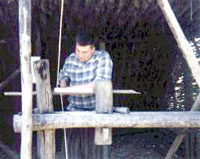
![]()
Search the Journey to Forever website – click HERE
|
Journey to Forever: Make a donation |
Navigation
Contact usTo Keith Addison Handmade Projects |
Appropriate technology resources
Wood
 "Wood Harvesting with Hand Tools: An Illustrated Training Manual" International Labour Office (ILO), 1987
"Wood Harvesting with Hand Tools: An Illustrated Training Manual" International Labour Office (ILO), 1987
This manual provides basic information on efficient and safe equipment and methods for manual wood harvesting, and helps to ensure full utilization of the raw material. It combines and updates two previous ILO publications: Felling and cross-cutting of tropical trees in natural forests (1969); and Selection and maintenance of logging hand tools (1970). Wood harvesting with manual tools continues on a large scale and, with a shift of emphasis to trees grown by rural people, will continue to gain importance. This manual fills a need for information on basic wood harvesting, excluding machines and techniques which in many developing countries are out of reach of the rural population (chainsaws). It also draws on Central European and Scandinavian resources where experience in manual logging in previous periods has been kept alive, with ongoing improvement of manual tools and techniques. The manual uses simple terms and lots of clear drawings. Buy at Amazon.com: Wood Harvesting with Hand Tools
Pole lathes
The pole lathe is one of man's oldest woodworking machines. Powered by the turner's foot, a cord, and the springiness of a green wood pole, a pole lathe could be set up anywhere in the forests and used to turn green wood products on the spot.

Great pictures of an ancient pole lathe at work:
http://www.gallica.co.uk/celts/polelath.htm
They were used by bodgers, skilled craftsman who made wooden chairs and a lot of other forest products from greenwood using a pole lathe deep in the woods. They're still used today by modern-day bodgers.
Green woodwork uses fresh-cut poles and cleft wood rather than seasoned sawn timber and planking. Green wood "works" differently, bends more easily, cleaves well, allows for glueless joints, and cuts well on a pole lathe. Windsor and ladderback chairs are traditionally made of green wood. Other products are stools, hurdles, tent pegs, spoons, tool handles, rolling pins and more. Once fashioned, the wood is dried in a simple kiln.

Turned on a pole lathe
Pole Lathe Turning -- 2,800-word article on pole lathes, what they are, what they do, how to use them, and how to build one, with diagram.
http://members.lycos.co.uk/handforged/polelathe.html
 "Green Woodwork -- Working with wood the natural way" by Mike Abbott, Guild of Master Craftsmen, 1989, reprint 1999, Sterling Publishing, ISBN 0946819181
"Green Woodwork -- Working with wood the natural way" by Mike Abbott, Guild of Master Craftsmen, 1989, reprint 1999, Sterling Publishing, ISBN 0946819181
Abbott uses axes for rough sizing, saws for cutting to length, froes for splitting to proper dimensions, a few edged tools such as drawknives for shaping, braces and bits for fashioning holes, and a pole lathe for turning. Detailed discussion on the design and making of a pole lathe and a shaving horse. Chair making, utensils, fences, rakes, brooms and more. Buy at Amazon.com: Green Woodwork
 "Green Woodworking: A Hands-On Approach" by Drew Langsner & Carol Taylor, 1995, Lark Books, ISBN 0937274828.
"Green Woodworking: A Hands-On Approach" by Drew Langsner & Carol Taylor, 1995, Lark Books, ISBN 0937274828.
Basic information for traditional woodworking with hand tools. Chapters on materials, tools (including sharpening), setting up a shop, followed by sections on various techniques: knife-work, hewing, riving, shaving, boring, bending, and joinery. A sample project with each technique. Buy at Amazon.com: Green Woodworking
Great woodworking tools -- adzes, carving knives (straight, hooked), chairmaker's tools (inshaves, travishers), drawknives, gouges (bowl carver's and sculptor's), axes (carving, hewing, forest, camping), riving tools, from the Country Workshops Store:
http://www.countryworkshops.org/store.html
Appropriate technology
Appropriate technology resources
- Agriculture resources
- Wood resources
Blacksmithing
Wood fires that fit
Houses that fit
Water-powered water pumps
Journey to Forever and AT
- Chinese watering cans
- Handmade Projects watering can plans
- Hoe for victory!
- Billhooks and sickles
A better rat trap
- Rats and owls
- Chinese rat trap
- How to make a Chinese rat trap
- Bucket rat trap
Appropriate technology subjects